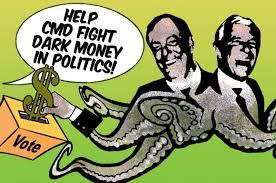
(Leah Hogsten | The Salt Lake Tribune)
Burnt sagebrush and oil-covered junipers line the perimeter of the pond
at Citation Oil Company's #11 oil well leak in Dixie National Forest,
Wednesday, April 2, 2014. "The oil made its way under the snow to a pond
that was directly downhill from the release," according to a Forest
Service statement. "On several occasions since the release, Citation Oil
personnel ignited and burned off the oil that had gathered on top of
the pond and around the edges." This spill is located about 10 miles
southwest of the town of Escalante and about three miles north of the
Little Valley leak in the Upper Valley Oil Field.
Another oil leak reported in southern Utah
Newest spill » Citation Oil leak in Dixie National Forest is near the one discovered in Grand Staircase Monument.
By Christopher Smart
| The Salt Lake Tribune
First Published Apr 02 2014 05:07 pm • Updated 5 hours ago
Days after an unreported Citation Oil and Gas
Corp. spill within the Grand Staircase came to light, the U.S. Forest
Service announced Wednesday a second leak from the same company.
The size of the spill in Dixie National Forest
remains uncertain, according to Forest Service spokesman Joe Harris. He
said the agency is unsure whether the leak exceeds 10 barrels, the
prerequisite for a "reportable incident" under federal guidelines.

"We wanted to get this [information] out there," he said. "We aren’t trying to hide anything."
The spill was discovered by the Forest Service
on March 24, but the company said it may be related to a repair made in
November, Harris said.
Recently, officials from the Bureau of Land Management reported another Citation Oil leak in Little Valley Wash within Grand Staircase-Escalante National Monument. It remains unclear how old that oil leak is.
The Dixie National Forest abuts the national
monument in southern Utah’s Garfield County. The new leak is about 10
miles southwest of the town of Escalante and about 3 miles north of the
Little Valley leak in the Upper Valley Oil Field, Harris said.
Representatives of the Houston-based oil firm
told Forest Service investigators that an undetermined amount of oil was
released during the repair of a valve in November, according to a
Forest Service statement.
"The oil made its way under the snow to a pond that was directly downhill from the release," the statement said.
"On several occasions since the release,
Citation Oil personnel ignited and burned off the oil that had gathered
on top of the pond and around the edges."
Such burning is allowed under the operation plan for the oil field, according to the Forest Service.
The preliminary investigation has found no evidence that the oil traveled beyond the pond, the agency officials said.
The BLM and Forest Service are not adequately
protecting public lands from the oil and gas industry, said Neal Clark
of the Southern Utah Wilderness Alliance.
"This, unfortunately, is another example of the agencies failing to protect public lands," Clark said.
The federal agencies apparently lack the resources to provide oversight of oil and gas companies, Clark added.
"If BLM and the Forest Service don’t have the resources to protect our public lands, they shouldn’t be leasing them."
The Dixie National Forest is working with Citation Oil on a cleanup plan for the oil leak, according to Harris.
The Forest Service is recommending that the
water be removed from the pond, along with oil residues and contaminated
soil in the area.















 Denver Post publishes a new False Media Section called: "ENERGY and ENVIRONMENT
Denver Post publishes a new False Media Section called: "ENERGY and ENVIRONMENT


































